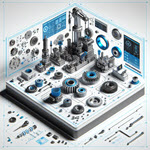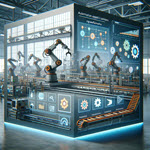
Why should I use TopSolid API: Automation?
Updated : 28 November 2024
 What is an API?
What is an API?
API stands for "Application Programming Interface" and can be translated as a programming interface. APIs allow third-party developers to access a selection of features related to the software, serving as an entry point to another software system. An API enables two programs to communicate with each other, exchange data, and perform tasks automatically.
APIs have been used and well-known within the software development sphere for about twenty years. A common example used to illustrate an API is the one provided by Google Maps, which offers geographic data that can easily and quickly adapt to any software or website. As a result, Google Maps has naturally become the most widely used mapping service among consumers.
 Why is the use of APIs essential for Industry 4.0?
Why is the use of APIs essential for Industry 4.0?
The use of an API allows interaction with a system without worrying about its complexity or internal workings. By definition, an API is designed to be simple to use. The easier it is for a developer to understand an API, the easier it will be to use. Developer experience is crucial, as it significantly reduces the learning curve for the tool, thereby also cutting down development time. Instead of needing to understand the complete workings of a software's often closed and inaccessible source code, developers only need to grasp how the API functions.
In the context of Industry 4.0's expansion—encompassing the Internet of Things (IoT), cloud computing, autonomous robots, and ERP system connectivity—APIs play a key role in industrializing information exchange. They also help optimize and expand usage scenarios, driving further innovation and efficiency.
 Automation system design
Automation system design
During the development of Automation, one fundamental rule emerged: Simplicity. Automation was designed in such a way that an advanced TopSolid user, even without development knowledge, could create small applications. All the exposed methods are based on actions that can be performed manually in TopSolid. Therefore, an advanced user can define their development plan simply by using TopSolid and translating their ideas into code by calling the Automation functionality.
 Automation application functionalities
Automation application functionalities
Automation enables a wide range of functionalities in TopSolid, from the simplest tasks, such as exporting information from various documents, to fully automatic machining of complex parts with zero clicks.
Automation allows manipulation of:
- The PDM: The integrated document management system within TopSolid.
- Shapes
- Sketches
- Entities
- Operations
- Importing and exporting external files
- Assemblies and their components
- Bill of materials documents
- Mechanisms
- Machining documents, including machining operations and the application of method documents.
- ISO file generation from CAM operations.
- And many more...
Below is a video showcasing a program developed using Automation that enables the following tasks to be performed automatically:
- Importing a DXF part.
- Creating machining preparation documents, including raw material management.
- Creating the machining document.
- Machining the part.
- Generating the corresponding ISO files.
Repositioning the part for machining additional faces.
 How can I get an Automation training ?
How can I get an Automation training ?
You have two possibilities to be trained on TopSolid Automation subject:
- You can attend a full e-learning training
- Or, you can learn with basic exercises from Self-Learning section and examples shared on GitHub
 Automation support
Automation support
Two types of support are available:
TopSolid Forum
You can visit the TopSolid forum, where many users ask and answer questions. This is a great resource for sharing knowledge and finding solutions. You can access the english forum or the frenchPersonalized Support
For more tailored assistance, you can opt for an Automation Support Contract with our dedicated team. This provides direct and specialized help for your specific needs.GitHub Community Additional help is available through the GitHub community. Refer to this section to get more information.